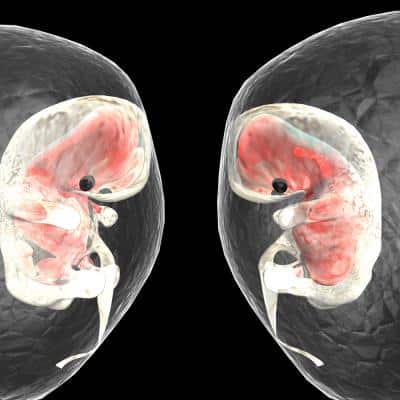What is Fetus in Fetu?
“Fetus in Fetu” is a rare pregnancy complication in which a fetus (or a mass of tissue tightly resembling a fetus) is present inside of another fetus. Fetus in fetu can be characterized as being alive or dead: it is considered “alive” when the tissues of the inside fetus have a viable blood supply, and it is “dead” when the tissues are non-functioning.
In a viable fetus in fetu and depending on the level of development of the internal organs, the internal fetus can present with a fully functioning gastrointestinal tract, urinary tract or even respiratory tract. However, its survival is strictly dependent on the blood supply of its host twin.
The condition, known as “fetus in fetu,” is caused by the incomplete separation of twins, when one fails to grow and instead becomes an internal part of the healthy twin.
It is believed there are only 200 reported cases of the rare condition worldwide.
The condition arises when a twin is absorbed by another in the womb, says Mark Umstad at the Royal Women’s Hospital in Melbourne, Australia. This is only possible if the twin embryos originate from the same egg and share the same placenta, he says.
Embryos start out as flat discs, but at 4 weeks of development, they begin to fold to form the basic body shape. The close proximity of identical twins means that one can sometimes be folded into the other during this process. Some experts believe that a twin is more likely to be absorbed in this way if it has an existing defect.
The location of the fetus in fetu depends on where it gets trapped during the folding process, Umstad says.
Advances in fetal ultrasound have made it easier to detect parasitic twins during pregnancy, allowing them to be surgically removed soon after birth. But sometimes they are not discovered until much later. For example, in the early 1990s, a fetus was found in the upper abdomen of an Italian man who was 47 years old.
The condition is often asymptomatic, but it can cause pain if the fetal mass pushes against the host twin’s internal organs. It can also lead to malnourishment because the trapped twin draws from the host’s nutrients.
It is possible that the incidence of a fetus in fetu will increase as assisted reproductive treatments become more common because they increase the chance of conceiving identical twins, says Umstad. “However, since fetus in fetu only occurs in about 1 in 500,000 births currently, we might be talking about one extra case a year globally,” he says.
 How Does a Fetus in Fetu Develop?
How Does a Fetus in Fetu Develop?
The question of how a parasitic twin might develop is one that currently his unknown to everyone. One of the most popular theories on the phenomena states that’s during gestation, one twin essentially absorbs the other in the womb.
This happens very early in gestation, and though most experts agree that this action would prompt a miscarriage relatively early in the pregnancy, it is possible for the stronger twin to survive and to thrive, living their lives without knowledge of the fetus at all.
It is entirely possible that the condition could go for years or even decades without being noticed, as it did in the case of one man who lived with the effects of a parasitic twin for more than thirty years.
Another competing theory states that the condition known as fetus in fetu is dramatically misnamed and contends that the tissue known as the fetus is not, in fact, a fetus at all, but a form of tumor. A teratoma, which might also be known as a dermoid cyst, is a sort of highly advanced tumor that can develop human skin, sweat glands, pores, and hairs. Because of their unique nature, these tumors may also contain cartilage, eye tissue, organ cells, and teeth. Some people find that it is entirely possible that teratomas can become advanced enough that they can even form primitive organ systems.
Are There Others With a Fetus in Fetu Alive Today?
Alamjan Nematilaev’s case is made even more extraordinary due to the fact that the fetus had the rough configuration of a human being; it had a head, four limbs, hands, fingernails, hair and recognizable if misshapen face. In most cases, the fetus that resides in the person who has this condition is much more primitive and only marginally recognizable as being a human fetus. The fetuses that are found in these cases are always discovered to be without brains and incapable of living away from the person within whom they developed. This condition is a parasitic one, where the fetus needs the host to survive, giving rise to the more common name of the parasitic twin.
Besides the case of Alamjan Nematilaev, there have been several other people who have carried a parasitic twin.
In recent years, a very young child in China was found to have his own twin inside his body. He actually appeared to be pregnant with a huge protruding belly. Successful surgery was done to remove the parasitic twin.
In some cases, the fetus in fetu condition can be diagnosed even before birth, as in the case of a Chilean boy in Santiago, or a few months after the birth, as in the case of a two-month-old girl in Pakistan.
In 2005, a two-day-old baby received an operation to remove a small abdominal mass and discovered a fetus the size of a fist inside him; this case of fetus in fetu is distinguished by being the first where movement of the parasitic twin has been documented via ultrasound.
Recently, The 3-month-old baby was admitted to the hospital for treatment in new york for a kidney mass after his parents noticed his stomach was swelling up.
But when doctors operated, they found a 2-pound parasite twin — complete with eyes and skin — that was feeding off the baby.
Dr. S.P. Sharma, who cared for the baby, said: “The baby was wrongly diagnosed with a tumor.”
“We were surprised and shocked to see a malformed fetus inside his stomach.”
“We have successfully operated to remove the parasite twin out of his body.”
“The baby is recovering well from the operation.”
fetus in fetu symptoms
The major presenting complaint is a palpable abdominal mass, predominantly in the upper abdomen. The other symptoms are secondary to the mass effect of the FIF such as jaundice, hydronephrosis, intestinal obstruction, meconium peritonitis, respiratory distress, and vomiting
Treatment of Fetus in Fetu
The recommended treatment for the fetus in fetu is surgical removal of the parasitic fetus. In patients that are diagnosed in adulthood, it is possible for them to develop a bond with their twin brother or sister, and they might refuse to proceed to the removal of their parasitic twin. However, care should be taken and adequate advice should be given regarding the benefits of doing the procedure and the risks of not doing it.
Medical References of Fetus in fetu
- The Twin Pregnancy and Beyond
- https://www.twin-pregnancy-and-beyond.com/fetus-in-fetu.html
- A Case of Fetus in fetu.
- https://www.ncbi.nlm.nih.gov/pmc/articles/PMC3418045/
- New Scientists
- https://www.newscientist.com/article/2126058-baby-has-surgery-to-remove-parasitic-fetus-growing-inside-him/



 How Does a Fetus in Fetu Develop?
How Does a Fetus in Fetu Develop?

